
Anacamptis pyramidalis, the pyramidal orchid, is a perennial herbaceous plant belonging to the genus Anacamptis of the family Orchidaceae. The scientific name Anacamptis derives from Greek ανακάμτειν 'anakamptein' meaning 'bend forward', while the Latin name pyramidalis refers to the pyramidal form of the inflorescence.

The genus Ophrys is a large group of orchids from the alliance Orchis in the subtribe Orchidinae. They are widespread across much of Europe, North Africa, Caucasus, the Canary Islands, and the Middle East as far east as Turkmenistan.
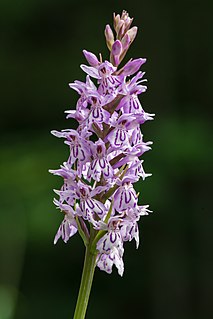
Dactylorhiza is a genus of flowering plants in the orchid family Orchidaceae. Its species are commonly called marsh orchids or spotted orchids. Dactylorhiza were previously classified under Orchis, which has two round tubers.

The pig-tailed langur, monotypic in genus Simias, is a large Old World monkey, endemic to several small islands off the coast of Sumatra in Indonesia. Its face is black, its fur is blackish-brown and it has a relatively short tail. It is a diurnal species, feeding in small groups in the rainforest canopy on leaves, and to a lesser extent, fruit and berries. Little is known of its natural history, but it is heavily hunted, its populations have been declining rapidly and the International Union for Conservation of Nature has assessed its conservation status as being "critically endangered". It has been included on a list of the World's 25 Most Endangered Primates.

Anacamptis morio, the green-winged orchid or green-veined orchid, is a flowering plant of the orchid family, Orchidaceae. It usually has purple flowers, and is found in Europe and the Middle East.

Orchis purpurea, the lady orchid, is a herbaceous plant belonging to the genus Orchis of the family Orchidaceae.
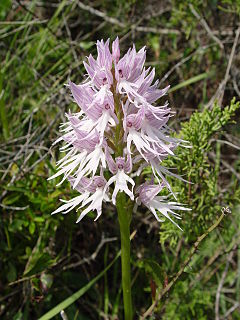
Orchis is a genus in the orchid family (Orchidaceae), occurring mainly in Europe and Northwest Africa, and ranging as far as Tibet, Mongolia, and Xinjiang. The name is from the Ancient Greek ὄρχις orchis, meaning "testicle", from the appearance of the paired subterranean tuberoids.

Cephalanthera rubra, known as red helleborine, is an orchid found in Europe, North Africa and southwest Asia. Although reasonably common in parts of its range, this Cephalanthera has always been one of the rarest orchids in Britain.

Orchis mascula, the early-purple orchid, early spring orchis, is a species of flowering plant in the orchid family, Orchidaceae.
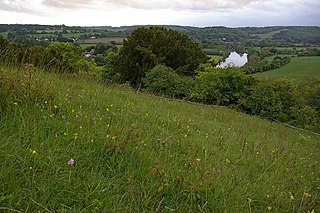
Hartslock, also known as Hartslock Woods, is a 41.8-hectare (103-acre) biological Site of Special Scientific Interest (SSSI) in a wooded area on the north bank of the River Thames to the south-east of Goring-on-Thames in the English county of Oxfordshire. An area of 29.4 hectares is a Special Area of Conservation and an area of 10 hectares is a nature reserve owned and managed by the Berkshire, Buckinghamshire and Oxfordshire Wildlife Trust (BBOWT). The site is well known for the variety of wild orchids that grow on its sloping grassland, and especially for the monkey orchid that grows in very few other places in England.
NVC community CG2 is one of the calcicolous grassland communities in the British National Vegetation Classification system. It is one of three short-sward communities associated with heavy grazing, within the lowland calcicolous grassland group, and is regarded as "typical" chalk grassland.

Park Gate Down or Parkgate Down is a 7-hectare (17-acre) biological Site of Special Scientific Interest south-east of Stelling Minnis in Kent. It is also a Special Area of Conservation and is managed by the Kent Wildlife Trust,
Hector Mark Wilks was an English botanist and conservationist. A retired chartered surveyor, he was chairman of the Kent Trust for Nature Conservation. He was also a Councillor on the Whitstable Urban District Council. He is perhaps best known for rediscovering the monkey orchid in Kent at a site near Faversham and subsequently introducing the species to Park Gate Down near Elham. The site near Faversham remains one of only two native sites for the monkey orchid in the British Isles and has remained closed to the public since its discovery. On 21 May 2007, Park Gate Down was renamed "The Hector Wilks Reserve" in recognition of his involvement with the reserve from its inception.
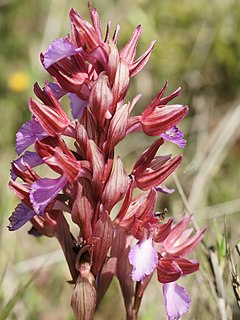
Anacamptis papilionacea is a species of flowering plant in the orchid family Orchidaceae. It is commonly known as the pink butterfly orchid.

Orchis italica, the naked man orchid or the Italian orchid, is a species of orchid native to the Mediterranean Basin. It gets its common name from the lobed lip (labellum) of each flower which mimics the general shape of a naked man. In Italy, it is believed that the consumption of the plant is conducive to virility. It prefers partial shade and low nutrient soil, and flowers in April. Orchis italica grows up to 50 centimetres (20 in) in height, with bright pink, densely clustered flowers.
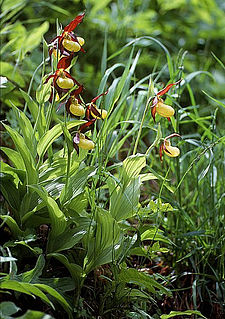
Cypripedium calceolus is a lady's-slipper orchid, and the type species of the genus Cypripedium. It is native to Europe and Asia.

Galearis rotundifolia is a species of flowering plants in the orchid family, Orchidaceae. It is commonly called roundleaf orchis and small round-leaved orchid. It is a succulent perennial herb native to North America, where it occurs throughout Canada, part of the northern United States, and Greenland.

The natural history of the island of Rhodes is determined by its geographic position, climate and geological diversity. Rhodes is in the Eastern Mediterranean Basin close to the coast of Turkey, and the flora and fauna are a mixture of Mediterranean and Asian elements. Rhodes is in the Eastern Mediterranean conifer-sclerophyllous-broadleaf forests ecoregion.
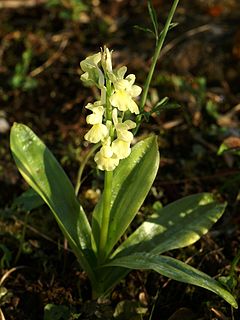
Orchis pallens, the pale orchid or pale-flowered orchid, is a perennial herbaceous plant belonging to the genus Orchis of the family Orchidaceae. It is found in most of Europe ranging from Spain across to the Caucasus. It blooms in spring with pale yellow flowers.


















